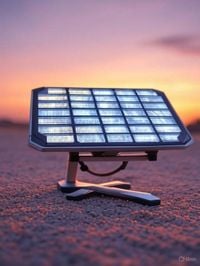In the ever-heating race to cool the planet, a small startup with outsized ambitions is making waves—and stirring controversy—by proposing to dim the very sun itself. Stardust Solutions, a US-Israeli company founded in 2023, has placed itself at the center of the solar geoengineering debate, promising a radical new tool to tackle climate change. Their plan? Release reflective particles high into the stratosphere, mimicking the cooling effects of volcanic eruptions and, in theory, buying the world precious time to cut greenhouse gas emissions.
This bold approach, known as solar geoengineering or stratospheric aerosol injection, is not exactly new. The idea first gained serious traction after scientists observed the aftermath of the 1991 Mount Pinatubo eruption in the Philippines, which spewed so much ash and particles into the atmosphere that it cooled the planet by about half a degree Celsius for over a year. According to The US Sun, Harvard University researchers developed the modern version of this concept several years ago, proposing to inject millions of tons of tiny, sunlight-reflecting particles into the upper atmosphere using balloons or aircraft. The aim: halve future temperature rises by dimming the sun’s rays.
Stardust’s technology takes this concept a step further. With $60 million in fresh funding and a team that includes ex-nuclear scientists and military-linked experts, the company is developing proprietary aerosols designed to linger longer in the stratosphere than natural alternatives like sulfur dioxide. Their CEO, Yanai Yedvab, a former Israeli government physicist, envisions fleets of high-altitude aircraft dispersing these particles at 60,000 feet, blocking 1-2% of incoming sunlight. According to Heatmap News, Stardust claims its particles are made of components "abundant in nature, chemically inert in the stratosphere, and safe for humans and ecosystems." The company’s website assures, “The particles naturally return to Earth’s surface over time and recycle safely back into the biosphere.”
But the promises of rapid cooling come with a heavy dose of uncertainty—and not a little fear. Placing just ten of these high-tech balloons or aircraft around the globe could, by some estimates, cut global temperatures by 2°C within two years. That sounds like a miracle fix for a planet in peril. Yet, as Politico and Undark report, many scientists warn that such a sudden drop in temperature could have disastrous side effects: droughts, extreme rainfall, or even hurricanes in vulnerable regions. Modeling by climate scientists suggests that shifts in monsoon patterns could devastate agriculture in places like sub-Saharan Africa or South Asia. As Janos Pasztor, a former United Nations climate official and executive director of the Carnegie Climate Governance Initiative, put it, “There will be winners and losers.”
Pasztor’s brief involvement with Stardust adds a layer of intrigue—and caution—to the story. Initially recruited by the startup in early 2024 to advise on governance, he soon distanced himself from the project, citing deep concerns about the risks of dependency and the catastrophic “termination shock” that could occur if geoengineering deployments were suddenly halted. In a recent Politico profile, Pasztor recalled a Zoom call with Yedvab outlining plans to release millions of tons of particles, leaving him "stunned" by the seriousness and scale of the operation. He has since called for a global framework, perhaps under the UN, to assess risks and ensure that decisions about the planet’s thermostat aren’t left to a handful of private actors or wealthy nations.
If that sounds like science fiction, it’s worth noting that the regulatory landscape is, at best, patchy. The UN’s Convention on Biological Diversity has a moratorium on geoengineering deployments, but it’s non-binding and doesn’t cover small-scale experiments. Stardust insists it won’t proceed without global governmental approval, but the absence of clear international rules leaves the door open for unilateral actions—by startups, nations, or even rogue actors desperate for climate relief. A statement from the Center for International Environmental Law warns that Stardust’s experiments could violate international norms and disrupt weather patterns, agriculture, and ecosystems.
Public sentiment, as reflected in posts on X (formerly Twitter), is sharply divided. Some hail Stardust as a bold innovator—one user called it “volcanic ash on demand.” Others, including French commentator Silvano Trotta, brand the idea “psychopathic,” fearing undisclosed particle compositions or unintended ecological consequences. The specter of “playing God with the weather” looms large, with critics warning that privatizing planetary cooling could exacerbate global inequalities and sow geopolitical discord. European voices, such as German politician Nicole Höchst, point out that geoengineering is no longer a fringe topic, but a real-world issue with implications for food security and biodiversity.
Despite the controversy, Stardust’s business model is aggressively forward-looking. The company aims to make geoengineering profitable by patenting its sunlight-scattering technology for carbon credit markets or government contracts. According to Genetic Literacy Project, the cost of geoengineering could run into the billions annually—a bargain, some argue, compared to the trillions required for full decarbonization. Stardust’s initial outdoor experiments are slated for April 2026, potentially over Israel or the U.S., with full deployment targeted for 2030.
Industry insiders are watching closely. The backing of billionaire Chris Sacca’s Lowercarbon Capital signals a belief in the scalability of Stardust’s approach. Yet, ethicists and climate advocates question whether a 25-person startup should wield such planetary power. Comparisons abound to past controversial experiments, such as Russ George’s 2012 attempt at ocean fertilization, which drew international backlash. Pasztor and others urge transparency, calling on companies to publish particle details and impact assessments, and to involve indigenous groups and developing nations in the decision-making process.
For now, the world stands at a crossroads. As global temperatures continue to rise and climate tipping points loom, the temptation to “dim the sun” grows stronger. Pasztor’s Carnegie initiative pushes for a research moratorium until robust governance frameworks are in place. Proposals include a geoengineering treaty or oversight by the Intergovernmental Panel on Climate Change. As recent discussions on X and in news outlets like The Munich Eye and Axios make clear, the stakes are nothing less than the future of climate action itself.
In the midst of this debate, pop culture has not been silent. A 1995 episode of The Simpsons eerily predicted a solar geoengineering device—albeit wielded by the villainous Mr. Burns for his own gain. While Stardust’s motives may be nobler, the underlying questions remain: Can humanity safely engineer the climate? Who gets to decide? And what happens if something goes wrong?
As Stardust prepares for its first outdoor tests, the world must grapple with these dilemmas. The company’s audacious gamble embodies both the promise and peril of innovation in the climate era—offering hope for salvation, but demanding unprecedented caution and cooperation. The coming years will reveal whether this bold vision leads to global cooperation or chaos, but one thing is certain: the debate over geoengineering the planet has only just begun.




